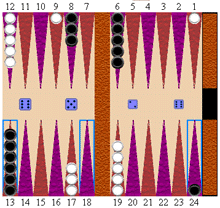|
Back to game
BackgammonThe History of BackgammonBackgammon is one of the oldest dice game known and one of the oldest classes of board games in the world. It is a two-player game. Backgammon has been known by many different variants and names for more than 5,000 years!. Start position and game object Backgammon and its variations make a little different game type from the "normal" board games on BrainKing.com. There is no square board with square fields, the game is played on a special triangles-in-two-rows desk. The other difference is that all moves are based on rolls of two dice which are randomly generated for each move. There are two sectors of the board called white and black home. White home is defined by 19-24 triangles and black home is made of 1-6 triangles. Each player starts with 15 pieces placed at specific positions:  The object is to remove all player's own pieces out of the board and avoid the opponent to do the same first. The game ends when all pieces of one player are removed. Movement of pieces When it is a player's turn, he/she must roll the dice and then move one or more his/her pieces according to the dice value. The dice are rolled automatically when the player on turn opens the corresponding game page for the first time (for this move). If the player tries to reload the game page or open it again later before making a move, the rolled dice will not change. The dice for the current move are displayed at the right half of the board (bigger dice) and the dice of the previous move of the opponent are shown at the left half of the board (smaller dice). If two different numbers are rolled, the player can make two moves at this turn. He/she takes the first (left-most) die value and moves one piece the same number of spaces. Then he/she does the same for the second die. Both moves can be done with the same piece or different pieces can be chosen for both moves. When two same numbers are rolled, the player can make four moves at this turn, all with the same die value (for example, if the dice show 5-5, four 5-spaces moves can be done). The white player moves the white pieces anti-clockwise (from the "1" triangle to "24") and the black player moves the black pieces clockwise. These pictures display one white and one black move (before and after the move):   The pictures above show that white moves one piece six spaces (from 9 to 15) and one piece three spaces (from 1 to 4).   The pictures above show that black moves four pieces four spaces (from 24 to 20, from 13 to 9, from 13 to 9 and from 6 to 2). A doubling cube Backgammon (and its variants) is the only game which can be defined as a match that employs a doubling cube. The match is specified by the number of points a player must reach to win. The number of received points for a single game (which is a part of the whole match) depends on scoring rules and the doubling cube value - all details will be described in the next sections. The cube is displayed at the right edge of the game board and its initial value is set to 1:  When a doubling cube is used in the game, each player begins a move with a choice to roll the dice (and make a normal move) or to offer a double. If a double offer is sent, the opponent must decide whether to accept it (and multiply the current doubling cube value by 2) or to reject it, which causes a loss of the current game and adding the doubling cube value number of points to the winner's score. Gammons and backgammons are not relevant when a cube offer is declined. (see Scoring in the next sections) If a double offer is accepted, the player who accepted the offer becomes the possessor of the cube which is shown on the player's side of the board with the new value. The next picture displays the board after the first double accept:  The value of the doubling cube can be increased to 4, 8, 16, 32 and 64. After the first double offer is accepted, the next offer can be sent only by the cube possessor - it means the following double offers always alternate between the players. Scoring After one player bears off all his/her pieces, the current game of the match is finished and the winner receives a number of points which depends on the final game position:
This number is multiplied by the current value of the doubling cube - for example, if the cube shows 4 and the winner scores the backgammon (3 points), he receives 12 points to the match score. Other important doubling cube rules
Other important rules
How to capture opponent's pieces The player captures an opponent's piece when he/she moves a piece to the triangle occupied by only one opponent's piece (it is called blot). After such move, the captured piece is removed from the board and placed to the bar. The following picture shows an example of white capturing black pieces (from 17 to 20, before and after white move).   How to remove own pieces out of the board The player can remove his/her own pieces when the following conditions are fulfilled:
Play this game See also: Backgammon, Nackgammon, Anti Backgammon, Backgammon Race, Crowded Backgammon, Hyper Backgammon, Cloning Backgammon, Grasshopper, Plakoto, Fevga |
Date and time
Friends online
Favourite boards
Fellowships
Tip of the day
|
|
||||||||||||||||||||||||||||||||||||||||||||||||||||||||||||||||||||||||||
Copyright © 2002 - 2024 Filip Rachunek, all rights reserved. Back to the top |























